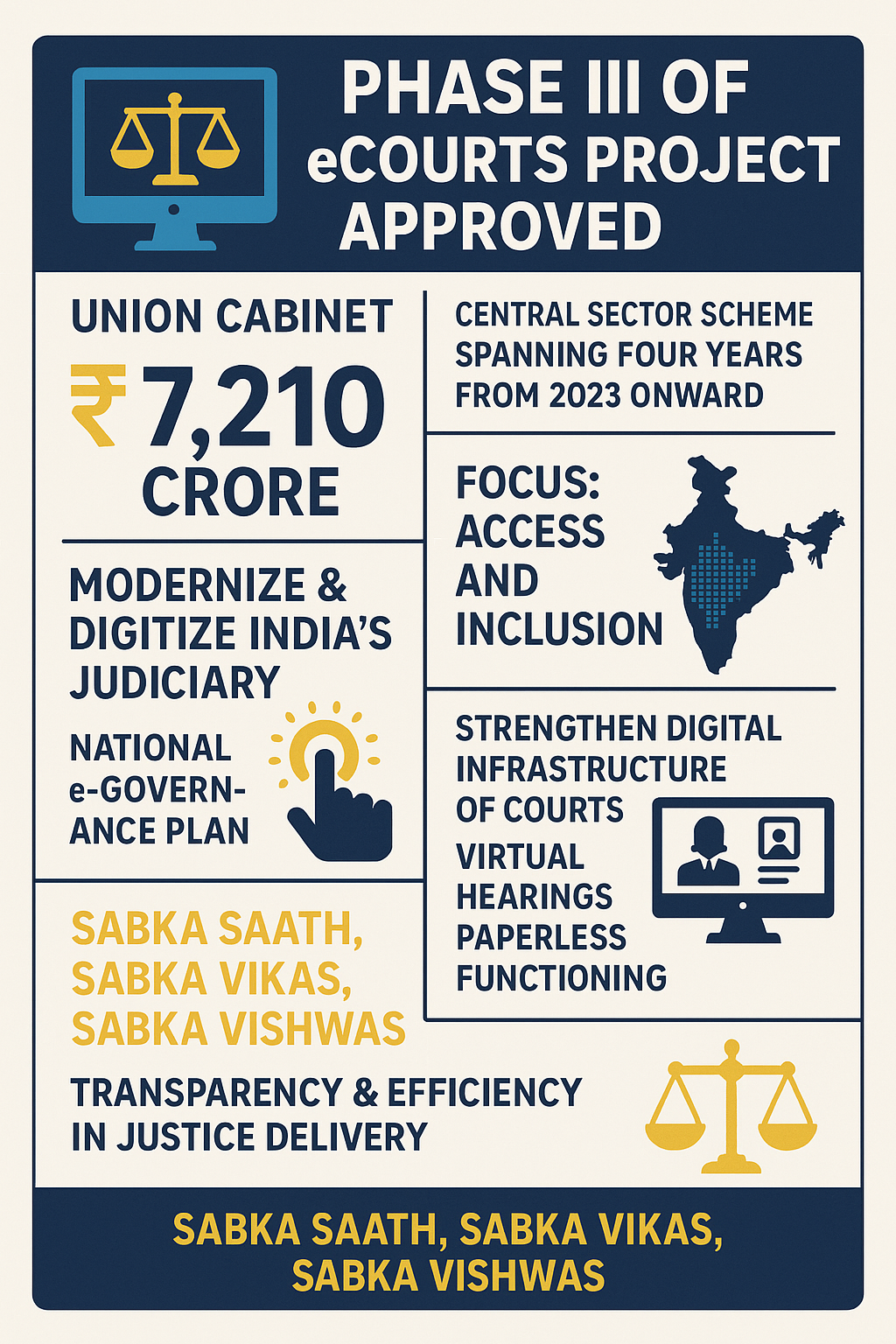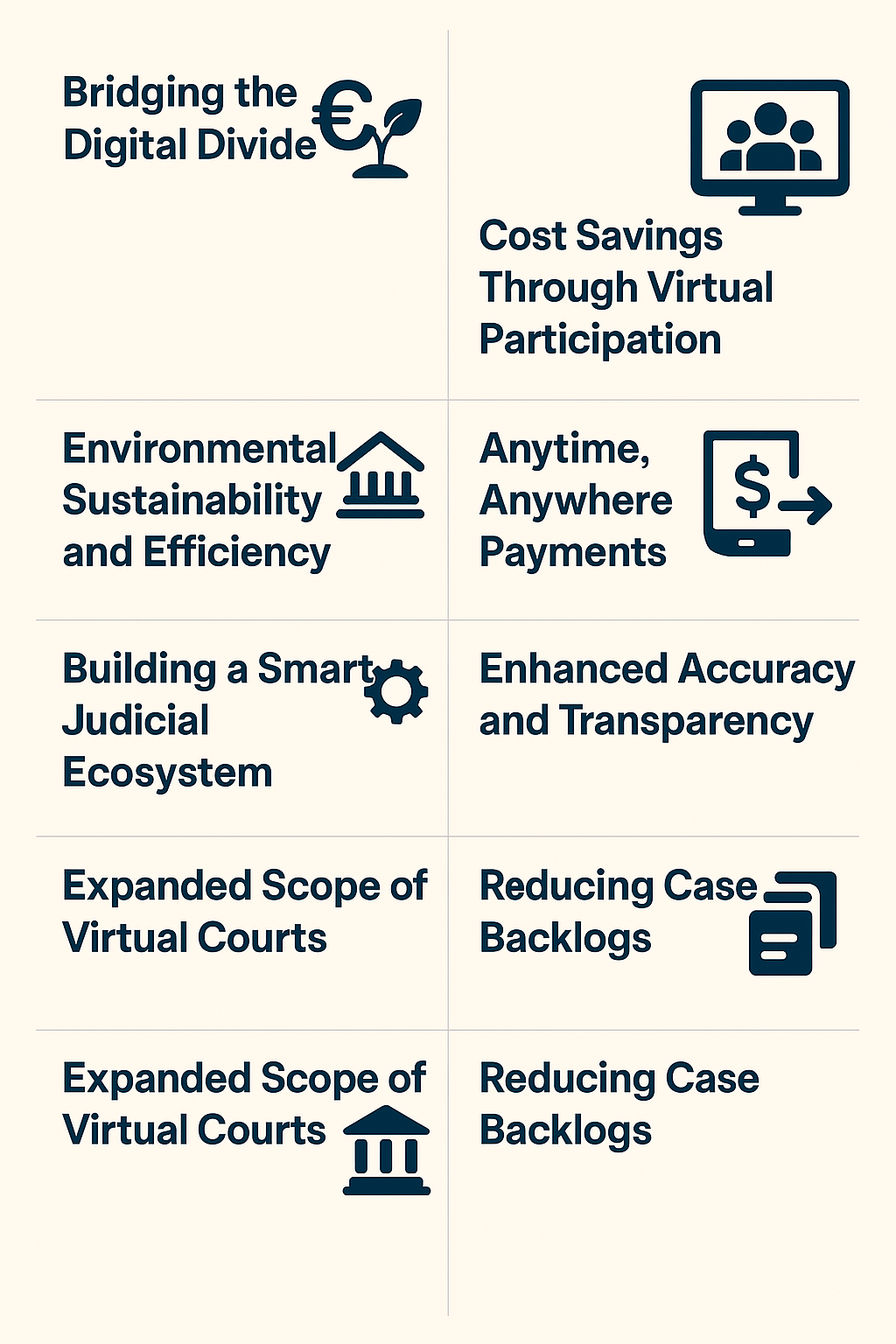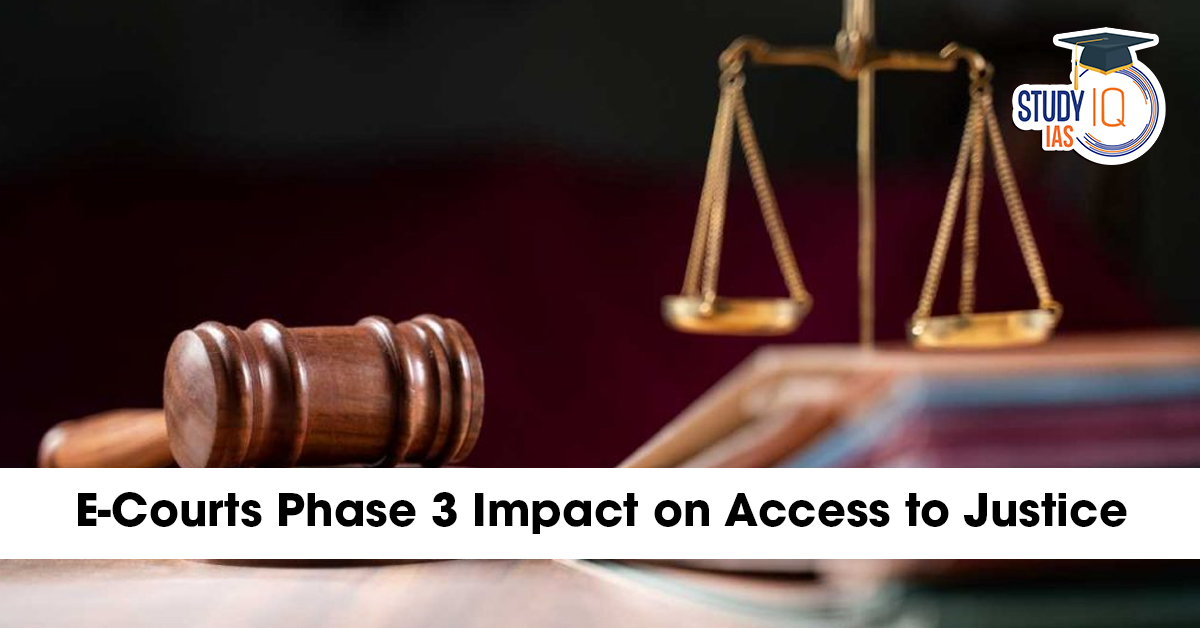Table of Contents
Why in the news?
The Union Cabinet has recently approved Phase III of the eCourts Project as a Central Sector Scheme spanning four years from 2023 onward, with a substantial financial outlay of ₹7,210 crore. This initiative aims to modernize and digitize India’s judiciary under the National e-Governance Plan. The primary focus is on “access and inclusion,” utilizing technology to enhance citizens’ access to justice.
Following the conclusion of Phase II in 2023, Phase III is set to strengthen the digital infrastructure of courts, facilitate virtual hearings, and encourage a paperless functioning environment. This project aligns with the government’s vision of “Sabka Sath, Sabka Vikas, Sabka Vishwas,” promoting increased transparency and efficiency within the justice delivery system.
Cabinet Approves eCourts Phase 3 for 4 Years: Introduction
The e-Courts Project, originally launched in 2007 under the broader framework of the National eGovernance Plan, has now progressed into its third phase of implementation. This new phase i.e., Phase III places a strong emphasis on the twin pillars of “access” and “inclusion, reflecting a shift toward a more citizen-centric and equitable justice delivery system.
In 2023, the Union Cabinet, under the leadership of Prime Minister Shri Narendra Modi, formally approved Phase III as a Central Sector Scheme. This phase is designed to be implemented over four years, with a substantial budgetary allocation of ₹7210 crore.
Aim of e-Courts Project
The primary aim of this phase is to create a unified digital infrastructure that enables seamless, paperless, and efficient interactions among courts, litigants, and other stakeholders. By grating technology into every layer of the judicial process, the project seeks to enhance transparency, reduce procedural delays, and streamline case management. This includes digitization of case records, universalization of e-filing and e-payments, and the expansion of virtual courts and eSewa Kendras to bridge the digital divide.
In essence, e-Courts Phase III envisions a modern, technology-driven judicial ecosystem that not only replicates existing processes digitally but reimagines them to ensure greater accessibility, affordability, and accountability in the administration of justice.

eCourts Project Phase 3: Goals, Alignment, Components, and Implementation
The eCourts Project Phase 3 represents a transformative effort aimed at modernising the Indian judiciary by transitioning from fragmented, paper-based processes to a unified, end-to-end digital ecosystem. This phase’s primary goal is to integrate various court functions—such as case filing, judicial orders, cause lists, and judgments onto a single, technology-driven platform.
By streamlining these processes, the initiative aims to eliminate physical paperwork, accelerate case registration and tracking, standardize procedures across all courts, and empower litigants through self-service portals. Collectively, these measures seek to reduce procedural delays, minimize manual errors, and deliver justice that is both swift and consistent.
This ambitious project aligns closely with Prime Minister Narendra Modi’s mantra, “Sabka Sath, Sabka Vikas, Sabka Vishwas,” which emphasizes collective partnership, inclusive development, and institutional trust. By engaging diverse stakeholders such as High Courts, district courts, litigants, bar associations, and technology partners in co-design workshops, the project fosters buy-in at every level, ensuring collaboration throughout the implementation process.
Investment in e-Sewa Kendras and digital literacy initiatives guarantees that marginalized groups, women, and rural populations have access to e-filing and video hearings. Furthermore, mechanisms like real-time e-notifications and public dashboards enhance transparency, thereby bolstering public confidence in the judicial system.
To facilitate maximum ease of justice, Phase III introduces several key components that work synergistically. These include comprehensive scanning and digitization efforts to convert legacy case files into searchable formats, a universal e-filing portal that supports multiple languages and secure payment options, and AI-powered case management tools designed to optimize judicial rosters. The expansion of virtual hearings and citizen services through dedicated eSewa Kendras further extends the reach of justice, minimizing backlogs and enhancing administrative efficiency.
Implementation of this centrally funded scheme is structured through a collaborative governance framework. Led by the Department of Justice within the Ministry of Law & Justice, the project ensures policy direction and budgetary releases. The eCommittee of the Supreme Court, chaired by a sitting judge, formulates technical standards and monitors progress, while State and High Courts act as nodal authorities, appointing District eCourt Coordinators to oversee local rollouts. This cooperation among various stakeholders, including the National Informatics Centre for Software Development and civil society organisations for outreach, ensures the project is both effective and accountable.
In terms of implementation workflow, the process begins with policy formulation and the development of technical standards, followed by the assignment of nodal authorities and stakeholder engagement. Infrastructure setup, training initiatives, and pilot testing precede the full-scale implementation, with continuous monitoring and public awareness campaigns supporting the rollout.
As these systems take shape, the integration of AI-driven tools is set to play a crucial role in enhancing judicial decision-making. AI will facilitate case analysis and predictive analytics, automate document reviews, optimize scheduling, and provide enhanced decision support, all while improving public access to information through chatbots that assist litigants.
In conclusion, the eCourts Project Phase 3 is poised to revolutionise the Indian judiciary by embracing technology to improve processes and foster social equity. The emphasis on user education and robust training for legal professionals will be vital in ensuring these advancements are accessible and beneficial to all segments of society. Continuous engagement with stakeholders will play a critical role in refining project implementation, ultimately ensuring that the judiciary meets the needs of modern-day India while striving for fairness and efficiency in the delivery of justice.
Expected Outcomes of eCourts Project Phase III
Bridging the Digital Divide
Citizens who lack personal access to digital devices or reliable internet can obtain critical judicial services at eSewa Kendras. These kiosks, staffed by trained personnel, enable e-filing, status checks, and grievance redressal, ensuring no one is left behind by the digital transformation of courts.
Environmental Sustainability and Efficiency
Digitizing both current and legacy case files lays the groundwork for every subsequent online service. By moving away from paper-based filings and curbing the physical movement of documents between court offices, the judiciary not only reduces storage costs but also promotes eco-friendly practices.
Cost Savings Through Virtual Participation
Allowing witnesses, lawyers, judges, and experts to appear remotely slashes expenses tied to travel, accommodation, and security. Virtual hearings make it feasible for geographically dispersed stakeholders to join proceedings without incurring traditional financial and logistical burdens.
Anytime, Anywhere Payments
E-payment gateways integrated into the eCourts platform let litigants settle court fees, fines, and penalties from any location, at any hour. This round-the-clock facility cuts down on queue times and the need to visit cash counters, enhancing convenience and compliance.
Streamlined eFiling
A unified e-filing system reduces the time and effort required to submit documents. Automated checks flag incomplete or incorrect filings before submission, minimizing human error and preventing the generation of new paper-based records.
Building a Smart Judicial Ecosystem
Incorporating AI, Machine Learning, OCR, and Natural Language Processing creates an intelligent backbone for the courts. Registries benefit from reduced manual data entry and lighter file scrutiny, while smart scheduling and analytics tools help judges and administrators make data-driven decisions, optimize hearing calendars, and forecast resource needs.
Expanded Scope of Virtual Courts
Phase III extends virtual court capabilities far beyond traffic violations, enabling fully remote adjudication of a wide array of civil and criminal matters. Parties and their counsel can now handle entire cases from their homes or offices, further removing physical barriers to justice.
Enhanced Accuracy and Transparency
Digital workflows generate immutable audit trails for every filing, order, and communication. Public dashboards and real-time notifications furnish litigants with clear insights into case progress, bolstering trust through openness and reducing the scope for procedural irregularities.
Automated Summons Delivery
By scaling up NSTEP (National Serving and Tracking of Electronic Processes), the project automates the issuance and tracking of summons. Electronic delivery cuts down on service delays and helps preserve strict timelines for hearings, thereby speeding up trial cycles.
Reducing Case Backlogs
Deploying emerging technologies across court processes ranging from e-case management to virtual dispute resolution drives up procedural efficiency. This concerted digital push is expected to play a pivotal role in bringing down the enormous pendency of cases, ensuring quicker access to final judgments.



 Reserved vs General Quota: Supreme Court...
Reserved vs General Quota: Supreme Court...
 Supreme Court’s Interim Order on the W...
Supreme Court’s Interim Order on the W...



















